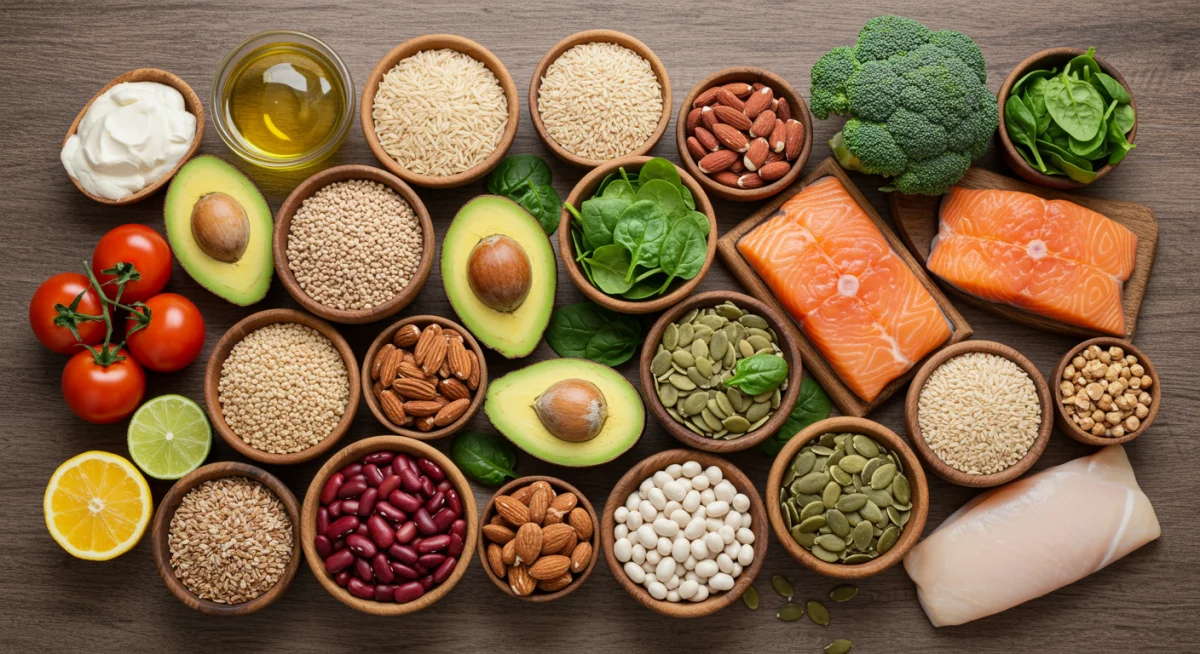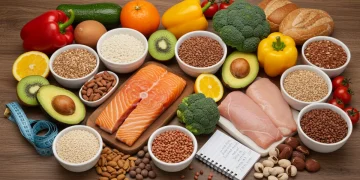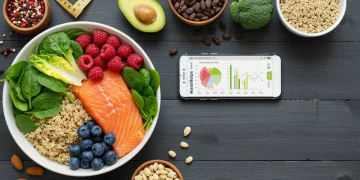Ultra-Processed Foods in 2025: Health Risks & Alternatives

The 2025 analysis of health risks associated with ultra-processed foods indicates a significant correlation with chronic diseases, necessitating a shift towards informed nutritional alternatives for public health.
As we navigate 2025, the conversation around our dietary choices has intensified, particularly regarding the pervasive presence of
ultra-processed foods impact on our health. These industrially formulated products, often high in sugar, unhealthy fats, and artificial additives, are increasingly recognized as a major contributor to a range of chronic health issues. This comprehensive analysis delves into the evolving understanding of their risks and explores viable nutritional alternatives.
Understanding Ultra-Processed Foods in 2025
Ultra-processed foods (UPFs) are no longer just a trend; they are a dominant force in modern diets, evolving rapidly with new formulations and marketing strategies. By 2025, our understanding of these foods has deepened, revealing a complex web of ingredients and production methods designed for convenience, palatability, and extended shelf life.
These products typically undergo multiple industrial processes and contain numerous ingredients, including many additives not commonly used in home cooking. Think of items like packaged snacks, sugary drinks, instant noodles, and ready-to-eat meals. Their appeal lies in their accessibility and often lower cost, making them a staple for many households.
Defining Ultra-Processed Foods
- Industrial Formulation: Products made primarily from substances extracted from foods (oils, fats, sugars, starches, proteins) or derived from food constituents (hydrogenated fats, modified starches, hydrolyzed proteins).
- Additives: Often contain flavor enhancers, colorings, emulsifiers, thickeners, and other cosmetic additives to mimic sensory properties of natural foods or make them more palatable.
- Ready-to-Consume: Designed for convenience, requiring minimal to no preparation before consumption, fitting into fast-paced modern lifestyles.
The industrial processing involved strips away many of the beneficial nutrients found in whole foods, such as fiber, vitamins, and minerals, while concentrating less desirable components. This nutrient dilution, coupled with the high caloric density, forms a critical part of their detrimental health profile. Understanding this distinction is the first step toward making informed dietary choices that prioritize long-term well-being.
The Escalating Health Risks: A 2025 Perspective
The scientific community in 2025 has amassed substantial evidence linking high consumption of ultra-processed foods to a myriad of adverse health outcomes. This evidence moves beyond mere correlation, suggesting a causal relationship in many instances, driven by both the composition of these foods and their impact on our eating behaviors.
The pervasive presence of UPFs in diets across the United States has contributed significantly to the ongoing public health crisis, particularly concerning chronic diseases. The ease of access and aggressive marketing further exacerbate the problem, making it challenging for consumers to avoid these products.
Chronic Disease Linkages
- Obesity: High caloric density, poor satiety, and addictive properties contribute to overconsumption and weight gain.
- Type 2 Diabetes: Rapid absorption of sugars, leading to insulin resistance and impaired glucose metabolism.
- Cardiovascular Diseases: High levels of sodium, unhealthy fats, and sugars contribute to hypertension, dyslipidemia, and inflammation.
- Certain Cancers: Emerging research suggests a link between UPF consumption and an increased risk of some cancers, possibly due to inflammatory effects and exposure to certain additives.
- Mental Health Disorders: Growing evidence points to a connection between UPF-heavy diets and increased risks of depression and anxiety, influencing gut-brain axis health.
Beyond the direct physiological effects, the consumption of ultra-processed foods often displaces healthier options, leading to nutrient deficiencies even in calorie-sufficient diets. This nutritional imbalance can weaken the immune system, impair cognitive function, and reduce overall quality of life. The long-term societal cost of these health issues is immense, placing a significant burden on healthcare systems.

Unpacking the Nutritional Deficiencies and Additives
The inherent nature of ultra-processing often means a significant loss of vital nutrients, while simultaneously introducing substances that may not be beneficial, or even harmful, to human health. In 2025, our understanding of these nutritional trade-offs and the role of various additives has become more refined, prompting calls for greater transparency and regulation.
Unlike whole foods that offer a complex matrix of vitamins, minerals, fiber, and phytonutrients, UPFs are frequently engineered to be palatable and shelf-stable, often at the expense of nutritional value. This creates a scenario where individuals can consume a high volume of calories without meeting their fundamental nutritional needs.
The Additive Conundrum
The array of additives found in ultra-processed foods is vast, designed to enhance texture, flavor, color, and preservation. While many are deemed safe by regulatory bodies, their long-term effects when consumed regularly and in combination are still under scrutiny. Some common additives include:
- Artificial Sweeteners: Linked to changes in gut microbiota and potential metabolic disruptions.
- Emulsifiers: May alter gut barrier function and contribute to inflammation.
- Artificial Colors and Flavors: Some studies suggest links to behavioral issues in children and allergic reactions.
- Preservatives: Used to extend shelf life, but some, like nitrates, have been associated with health concerns.
Beyond specific additives, the overall food matrix of UPFs, characterized by low fiber and high sugar/fat content, promotes rapid digestion and absorption, leading to blood sugar spikes and subsequent crashes. This can fuel a cycle of cravings and overeating, making it difficult for individuals to maintain a balanced diet. The lack of fiber also negatively impacts gut health, a crucial component of overall well-being.
Behavioral and Societal Impacts of UPFs
The influence of ultra-processed foods extends beyond individual health, permeating societal structures and influencing eating behaviors on a large scale. By 2025, it’s clear that the economics and marketing of these products play a significant role in their widespread consumption, particularly among vulnerable populations.
The convenience and affordability of UPFs make them an attractive option for busy families and individuals with limited budgets. This creates a disparity, where healthier, whole food options can be perceived as less accessible or too expensive, perpetuating a cycle of unhealthy eating.
Marketing and Accessibility
- Aggressive Marketing: UPF manufacturers often employ sophisticated marketing techniques, targeting children and adolescents, shaping dietary preferences from an early age.
- Convenience Culture: Modern lifestyles demand quick and easy meal solutions, perfectly met by the ready-to-eat nature of ultra-processed products.
- Economic Factors: Often cheaper per calorie than fresh produce or lean proteins, making them a default choice for those facing food insecurity.
Furthermore, the hyper-palatability of ultra-processed foods, achieved through precise ratios of sugar, fat, and salt, can override natural satiety signals, leading to overconsumption. This can contribute to altered taste preferences, making less intensely flavored whole foods seem bland by comparison. Addressing these behavioral and societal impacts requires a multi-faceted approach, combining public education with policy changes aimed at promoting healthier food environments.
Navigating Nutritional Alternatives: A 2025 Guide
In light of the growing concerns surrounding ultra-processed foods, identifying and adopting nutritional alternatives has become paramount. Thankfully, 2025 offers an abundance of resources and insights to help individuals transition towards a diet rich in whole, minimally processed foods, without sacrificing flavor or convenience.
The key is to focus on ingredients that are as close to their natural state as possible. This doesn’t necessarily mean spending hours in the kitchen; many simple, healthy meals can be prepared quickly and efficiently, often saving money in the long run compared to relying on expensive processed options.
Practical Strategies for Healthy Eating
Embracing a diet centered on whole foods involves a shift in mindset and a commitment to mindful eating. Here are some actionable steps:
- Prioritize Whole Grains: Opt for brown rice, quinoa, oats, and whole-wheat bread instead of refined grains.
- Increase Fruit and Vegetable Intake: Aim for a variety of colorful produce, both fresh and frozen, as they are packed with vitamins, minerals, and fiber.
- Choose Lean Proteins: Incorporate sources like chicken, fish, beans, lentils, and tofu.
- Healthy Fats: Include avocados, nuts, seeds, and olive oil in your diet for essential fatty acids.
- Cook at Home More Often: Preparing meals from scratch gives you full control over ingredients, reducing hidden sugars, salts, and unhealthy fats.
- Read Food Labels Carefully: Pay attention to ingredient lists, looking for minimal ingredients and avoiding items with long lists of unfamiliar names.
Making these changes doesn’t have to be drastic. Small, consistent steps can lead to significant improvements in overall health and well-being. Meal planning and batch cooking can also be invaluable tools for maintaining a whole-food-based diet, ensuring healthy options are always readily available.

The Future of Food: Policy and Innovation in 2025
Looking ahead to 2025, the conversation around ultra-processed foods is not just about individual choices but also about broader systemic changes. Policy initiatives and food innovation are beginning to play a crucial role in shaping a healthier food landscape, aiming to mitigate the negative
ultra-processed foods impact.
Governments and health organizations are increasingly recognizing the need for interventions that go beyond dietary guidelines, addressing the root causes of UPF overconsumption. This includes considering regulations on marketing, product reformulation, and incentivizing healthier food production.
Emerging Trends and Solutions
- Nutrient Profiling Systems: Labels like front-of-pack warnings or traffic light systems are gaining traction to help consumers quickly identify less healthy options.
- Food Education Programs: Enhanced educational initiatives in schools and communities are empowering individuals with the knowledge to make better food choices.
- Sustainable Food Systems: A growing focus on locally sourced, seasonal, and environmentally friendly food production supports access to fresh, whole foods.
- Technological Innovations: Advances in food science are exploring ways to create healthier, minimally processed alternatives that retain nutritional value and appeal.
The food industry itself is also facing increasing pressure to innovate and offer more nutritious options. While progress may be slow, the collective efforts of consumers, policymakers, and responsible food producers hold the promise of a future where healthy eating is not just a choice, but an accessible reality for everyone. Continued research into the long-term effects of UPFs and the development of effective interventions will be critical in this ongoing evolution.
Empowering Healthier Choices in a UPF World
Living in a world dominated by ultra-processed foods presents undeniable challenges, but it also offers opportunities for empowerment through informed decision-making. In 2025, understanding the subtle yet profound
ultra-processed foods impact on our health is the first step toward reclaiming control over our diets and well-being.
It’s not about achieving perfection, but about making consistent, conscious choices that favor whole, unprocessed foods whenever possible. This journey involves awareness, education, and practical strategies that fit into everyday life. Every small step towards healthier eating contributes to a cumulative positive effect on personal and public health.
Tips for Long-Term Dietary Success
- Start Small: Begin by replacing one ultra-processed item a day or a week with a whole-food alternative.
- Plan Ahead: Meal prepping and grocery lists can prevent impulsive, unhealthy food choices.
- Learn Basic Cooking Skills: Even simple recipes can transform raw ingredients into delicious, nutritious meals.
- Seek Support: Share your goals with family and friends, or join communities focused on healthy eating.
- Stay Informed: Keep up-to-date with nutritional science and public health recommendations.
Ultimately, the goal is to foster a sustainable dietary pattern that supports optimal health, energy, and longevity. By actively seeking out and embracing nutritional alternatives, individuals can significantly reduce their exposure to the risks associated with ultra-processed foods, paving the way for a healthier future for themselves and their communities. This proactive approach is essential in navigating the complexities of modern food environments.
| Key Impact Area | Brief Description |
|---|---|
| Health Risks | Increased incidence of obesity, type 2 diabetes, cardiovascular diseases, and certain cancers. |
| Nutritional Deficiencies | Loss of vital nutrients (fiber, vitamins, minerals) due to processing, coupled with high caloric density. |
| Behavioral Impact | Hyper-palatability leading to overconsumption and altered taste preferences, impacting healthy food choices. |
| Alternatives | Focus on whole, minimally processed foods, home cooking, and mindful ingredient selection. |
Frequently Asked Questions About Ultra-Processed Foods
Ultra-processed foods are industrial formulations made mostly from substances extracted from foods (oils, fats, sugar, starch, proteins) or derived from food constituents, often with additives. They are designed for convenience, palatability, and extended shelf life, typically containing ingredients not found in home cooking.
Regular consumption of ultra-processed foods is strongly linked to an increased risk of obesity, type 2 diabetes, cardiovascular diseases, and certain types of cancer. They often contribute to nutrient deficiencies and can negatively impact mental health and gut microbiota balance.
Look at the ingredient list: if it contains many unfamiliar ingredients, especially those you wouldn’t use in home cooking (e.g., high-fructose corn syrup, hydrogenated oils, artificial flavors/colors, emulsifiers), it’s likely ultra-processed. Prioritize products with short, recognizable ingredient lists.
Instead of chips or cookies, opt for fresh fruits, vegetables with hummus, nuts, seeds, plain yogurt, or homemade popcorn. These alternatives provide essential nutrients and fiber, promoting satiety and overall health compared to UPFs.
While complete elimination can be challenging given their pervasive nature, significant reduction is achievable and highly beneficial. Focus on gradually replacing UPFs with whole, minimally processed foods, cooking more at home, and being mindful of your ingredient choices to improve your diet substantially.
Conclusion
The 2025 analysis of the
ultra-processed foods impact underscores a critical juncture in public health. The mounting evidence linking these foods to a spectrum of chronic diseases necessitates a collective shift in how we approach nutrition. While challenges persist in a food environment often dominated by convenience and aggressive marketing, empowering ourselves with knowledge about health risks and viable nutritional alternatives is paramount. By prioritizing whole, unprocessed foods, supporting policies that promote healthier food systems, and making conscious dietary choices, we can collectively work towards a future where well-being is safeguarded against the pervasive influence of ultra-processed products. This journey is not just about individual health, but about fostering a healthier society for generations to come.





